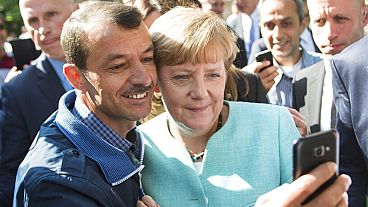EU leaders gather in Brussels to discuss the ongoing challenge of creating a Capital Markets Union. Euronews Business explains the aims behind the plan.
The CMU is an initiative designed to create a single market for capital across the EU. It aims to get investment and savings flowing across member states for the benefit of citizens, businesses and investors.
"The very existence of the CMU is like a power grid," said Rebecca Christie, Senior fellow at Bruegel, when she spoke to Euronews last month.
"The EU needs better financing," she explained. "It needs smaller companies to be able to scale up and access funds, which have to come from somewhere."
On Thursday, at an EU summit in Brussels, discussions about streamlined investment will take centre stage once again.
Almost a decade on from the CMU's conception, Euronews Business explores the significance of the policy.
What is the point of the CMU?
In 2015, former Commission president Jean-Claude Juncker announced his plans for a Capital Markets Union, presenting it as a tool to boost investment in the EU.
The purpose of the policy is to promote financial integration. In practical terms, this means that policy makers want to make it easier for businesses in one EU state to source funding from another EU state, allowing smaller enterprises to grow and create jobs.
At the moment, as the CMU is still stuck in the legislative pipeline, financial systems across the block remain fragmented along national lines. Country-specific laws are a hindrance to cross-border funding, forcing companies to be more reliant on banks, rather than private investors, for loans.
Whilst this means that it's more difficult for companies to get their hands on capital in the first place, it also makes the EU’s financial system more vulnerable to shocks.
The resilience provided by the CMU could benefit not only investors, but also those receiving the funding.
As any investor will know, spreading your money across different assets and countries provides you with added protection if one investment drops in value.
In other words, you shouldn't put all your eggs in one basket.
When it comes to those reliant on investment, an over-dependence on banks can also leave companies vulnerable during economic downturns, when it becomes more difficult to secure loans.
Having a pool of capital coming from a range of sources, the purpose of the CMU, would allow businesses to have a more robust funding stream.
Why is it different to the single market?
The CMU works hand in hand with the notion of the single market, but these two concepts aren't the same thing.
The single market is a broader policy that aims to ensure the free movement of goods, services, and persons across the EU - as well as the movement of capital.
The Capital Markets Union therefore feeds into the principle of the single market, but it is specifically focused on the financial sector.
Why could the CMU be transformative?
Boosting investment in the EU would not only help to boost growth, therefore creating more jobs, but it could also increase innovation.
If businesses have more money to expand, Europe is likely to see a proliferation of new products and technologies.
As well as increasing the global competitiveness of the bloc, this could allow the EU to turbocharge its green transition.
The CMU aims to increase investment in green bonds, where lenders give companies or governments money to spend on environmentally sustainable projects.
This could include renewable power and transport initiatives, or programmes designed to increase energy efficiency.
Those in favour of the CMU have equally emphasised the policy’s potential to improve EU defence funding, and to drive advances in AI technology.
Why has it taken so long to implement?
The Capital Markets Union has been in the works for a long time, and one reason for this delay is simply the complexity of the project in hand.
As creating a shared financial system involves streamlining a web of country-specific rules, it can’t be done overnight.
That said, the CMU is also being stalled by political opposition.
Whilst influential member states such as France and Germany have shown support for the policy, a number of nations are wary about handing more control to Brussels.
Opponents of the CMU have notably cited concerns about additional costs for their national finance industries.
Others fear that the union could widen the gap between smaller and more developed markets, as they believe it will be easier for established financial systems to reap the benefits.
Defendants of the scheme would argue that Europe doesn’t have a choice.
As the US benefits from its sophisticated Inflation Reduction Act, a policy funnelling private investment into green technology, some fear that the EU must move or be left behind.



